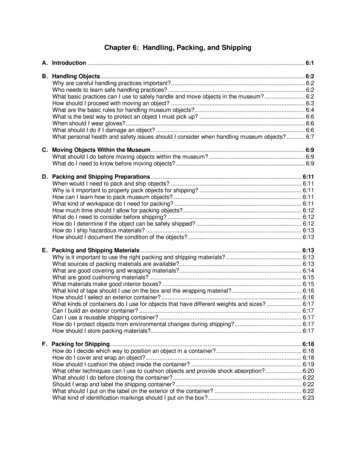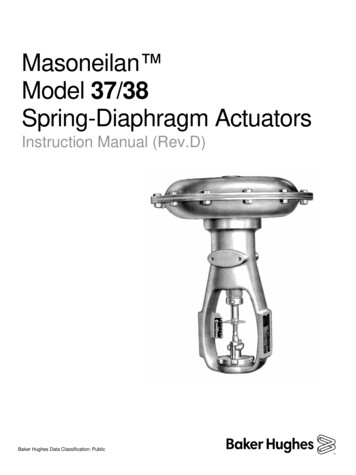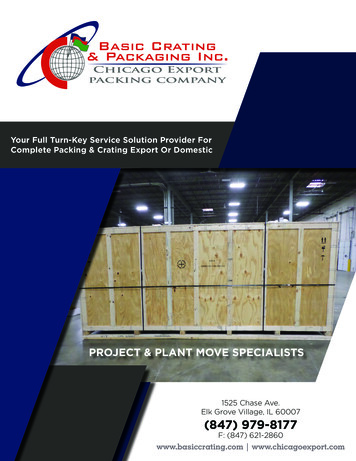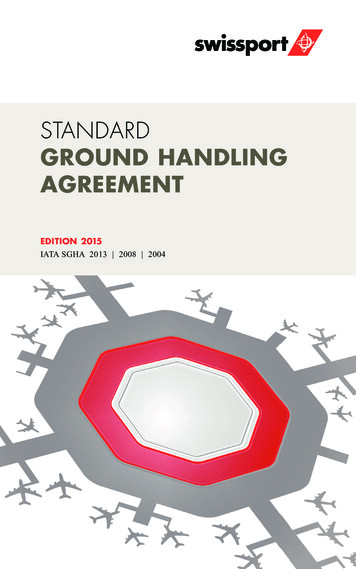
Transcription
Chapter 6: Handling, Packing, and ShippingA. Introduction . 6:1B. Handling Objects. 6:2Why are careful handling practices important?. 6:2Who needs to learn safe handling practices?. 6:2What basic practices can I use to safely handle and move objects in the museum? . 6:2How should I proceed with moving an object? . 6:3What are the basic rules for handling museum objects?. 6:4What is the best way to protect an object I must pick up? . 6:6When should I wear gloves?. 6:6What should I do if I damage an object? . 6:6What personal health and safety issues should I consider when handling museum objects? . 6:7C. Moving Objects Within the Museum. 6:9What should I do before moving objects within the museum? . 6:9What do I need to know before moving objects? . 6:9D. Packing and Shipping Preparations . 6:11When would I need to pack and ship objects? . 6:11Why is it important to properly pack objects for shipping? . 6:11How can I learn how to pack museum objects?. 6:11What kind of workspace do I need for packing? . 6:11How much time should I allow for packing objects?. 6:12What do I need to consider before shipping? . 6:12How do I determine if the object can be safely shipped? . 6:12How do I ship hazardous materials? . 6:13How should I document the condition of the objects?. 6:13E. Packing and Shipping Materials . 6:13Why is it important to use the right packing and shipping materials? . 6:13What sources of packing materials are available?. 6:13What are good covering and wrapping materials?. 6:14What are good cushioning materials? . 6:15What materials make good interior boxes? . 6:15What kind of tape should I use on the box and the wrapping material?. 6:16How should I select an exterior container?. 6:16What kinds of containers do I use for objects that have different weights and sizes? . 6:17Can I build an exterior container? . 6:17Can I use a reusable shipping container? . 6:17How do I protect objects from environmental changes during shipping?. 6:17How should I store packing materials?. 6:17F. Packing for Shipping . 6:18How do I decide which way to position an object in a container?. 6:18How do I cover and wrap an object?. 6:18How should I cushion the object inside the container? . 6:19What other techniques can I use to cushion objects and provide shock absorption?. 6:20What should I do before closing the container?. 6:22Should I wrap and label the shipping container? . 6:22What should I put on the label on the exterior of the container? . 6:22What kind of identification markings should I put on the box?. 6:23
G. Shipping Objects. 6:23What things should I consider if I use a professional packer/shipper? . 6:23What transportation alternatives are available for shipping museum objects?. 6:24When should I use the U.S. Postal Service?. 6:24When should I use commercial package delivery services? . 6:24When should I use an art shuttle van or special product truck? . 6:25When should I use airfreight? . 6:25Should I use a courier?. 6:25H. Receiving and Unpacking the Container. 6:26How should I unpack a container? . 6:26Should I check for insect infestation?. 6:27What do I do if an object is damaged, lost, or destroyed during shipping?. 6:27I. Selected Bibliography . 6:28List of FiguresFigure 6.1.Figure 6.2.Figure 6.3.Figure 6.4.Figure 6.5.Figure 6.6.Figure 6.7.Figure 6.8.Figure 6.9.Figure 6.10.Figure 6.11.Figure 6.12.Figure 6.13.Figure 6.14.Proper Handling Techniques. . 6:1Carts and Trays Minimize Handling. 6:2Equipment and Supplies . 6:3Hold Objects at the Strongest Point. 6:5Wear Gloves and Use Both Hands. . 6:6How to Lift Properly and Avoid Injury. 6:7The Proper Way to Lift a Chair. 6:8The Proper Way to Lift a Small, Framed Photograph. 6:8The Proper Way to Lift and Carry a Small Textile Object . 6:8Use Trays and Padding to Prevent Damage. 6:10Pad and Separate Parts. 6:19Wrapping, Padding, and Packing for Shipping an Object . 6:20Objects Double-boxed for Shipping. . 6:21Example of Written Handling Rules for NPS Park Collections. . 6:30
CHAPTER 6: HANDLING, PACKING, AND SHIPPINGA. IntroductionThis chapter outlines handling, packing, and shipping guidelines for safelymoving museum objects. By following these guidelines, you can preventdamage to the objects in your museum collection. The chapter includes: basic practices to ensure object safety guidelines for handling objects guidelines for moving objects inside the museum materials and techniques to properly pack for shipping basic directions for shipping objects guidelines for unpacking an object bibliography of references on handling, packing, and shipping museumobjectsSpecific guidance for handling different types of objects can be found in theappendices of this volume for each object type.Figure 6.1. Proper Handling Techniques.Proper handling techniques are essential to museumhousekeeping practices.NPS Museum Handbook, Part I (1999)6:1
B. Handling ObjectsWhen you touch, lift, or hold an object you are handling it. When youwork in a museum you will have to handle objects for a variety of tasks.To do this safely and effectively it is important to learn and practice goodhandling techniques.1. Why are careful handlingpractices important?Preventive conservation starts with careful handling. Proper handling islargely a matter of common sense and is necessary for the care andprotection of objects. However, good handling techniques are not alwaysobvious. Museum procedures require specialized handling knowledgethat must be learned. For example, metals can corrode after beinghandled without gloves. Paintings may crack as a result of bumping andjarring during movement. Mishandling can cause obvious examples ofdamage, such as shattered glass in a frame, broken ceramics, torndocuments, or dents and scratches in metal objects.Figure 6.2. Carts and Trays Minimize Handling.The use of equipment and supplies suchas carts and trays minimizes the need to handle objects.2. Who needs to learn safehandling practices?Anyone who handles museum objects needs to be aware of the guidelinesin this chapter. If your day-to-day responsibilities require you to handleobjects, you need to be sensitive to their delicate nature. Regularactivities like cataloging, photographing, housekeeping, and packing forshipment all require you to handle and work with objects.3. What basic practices can Iuse to safely handle andmove objects in themuseum?Write guidelines.Establish written guidelines to help foster a professional attitude andrespect for objects. Provide all staff with a set of written guidelines. Postthe guidelines in museum storage areas. Be sure that all staff who handleobjects read the guidelines. Researchers who handle objects should readthe guidelines when they first use the collections. Staff should read theguidelines when hired and review them periodically. See Figure 6.14 foran example of handling guidelines you can use.6:2NPS Museum Handbook
Train your staff.Don’t handle museum objects without training. Training should be anon-going activity, particularly when new types of objects are beinghandled. Make “hands-on” experience a part of all training forindividuals working with collections. Re-training reminds people of theimportance of proper handling techniques. You should give a specialtraining session whenever new staff members assist in handling objects.Use proper supplies and equipment.Only use equipment that is of good quality and in good condition.Equipment for moving objects includes flatbeds, carts, dollies, palletlifters, polyethylene tote pans, and object support trays. The supplies youuse with the equipment to move objects include polyethylene foam padsfor lining carts and trays, quilted furniture pads, acid-free tissue, andclean cotton or plastic gloves. You may need to acquire personalprotective equipment such as lab coats and smocks, safety glasses, dustmasks, and personally fitted respirators. Supplies and equipment arelisted in more detail below.Figure 6.3. Equipment and Supplies.Equipment and supplies for handling and moving museum objects includetrays, padding, tissue, gloves, and carts.4. How should I proceed withmoving an object?Consider safety first.Before moving an object, inspect equipment to ensure that the object andthe handler will be safe during the move. Do you have the properpersonal protective equipment? Identify the space where you will movethe object. Make sure there is room to house the object in its newlocation. If you have inadequate equipment, supplies, or space, postponemoving the object.Plan your move.Never consider moving an object routine work, even for daily housekeepingtasks. You must plan each step in the process before handling or moving amuseum object. Where will you stand before picking up the object? Isthere an open space to receive it? Planning helps keep handling to aminimum. When you plan, it helps you remember that each museum objectis special. Keep in mind the following factors when you plan to move anobject: NPS Museum Handbook, Part I (1999)Do you need to move the object? Is moving the object absolutelynecessary? If not, don’t move it.6:3
5. What are the basic rules forhandling museum objects? What are the object’s structural characteristics and condition? Is itstrong enough to withstand the move? Is there evidence of previous repairs? Review catalog records,condition reports, and photographs and examine the object to identifyprevious damage that may make the object especially fragile. Is theredocumentation that gives recommendations on moving hazards or safemoving techniques? What is the safest way to lift the item? How will you need to lift andcarry the object to protect it from damage? How many people are required? Do you need help to move theobject? Where is the object’s new location? Is it large enough to properlyhouse the object? Is the environment appropriate? What route will you use? Is it clear of obstructions? Will the personal health and safety of the handler be at risk? Do youhave the proper moving equipment (for example, lumbar support beltsor pallet jacks) to avoid physical strain? Do you need to wear a labcoat or dust mask?When you handle objects use common sense and follow these basic rules toprevent damage to objects: Treat every museum object as if it were irreplaceable and the mostvaluable piece in the collection. Handle objects only when necessary. Move only one object at a time. Note: Small items can be movedtogether in a tote pan if they are separated and supported by padding. Never hurry. Take no risks. Never smoke, eat, or drink while handling objects. Avoid wearing anything that might damage objects by scratching orsnagging the surface (for example, rings and other jewelry, watches,belt buckles, nametags, service badges). Use pencils, not pens, when working near objects. Keep hands clean, even when wearing gloves. Wear appropriate gloves. 6:4Wear white cotton gloves when handling most objects.NPS Museum Handbook
Wear plastic gloves (latex or nitrile gloves) when handling thesetypes of objects:slick objects like ceramics or glassobjects with oily or tacky surfaces that can attract cotton fibersfragile or damaged paper or other organic materials that maycatch on cotton fiberssome natural history specimens Know the condition of an object before moving it. Don’t lift by protruding handles or rims, which are oftenstructurally weak. Fragile objects should be given additional support, such as a trayor mount, before being lifted. Never layer or stack objects when moving them. Allow yourself plenty of space in which to work. Store objects so they can be easily moved without disturbing otherobjects. Tie on acid-free, cotton string tags or number trays, boxes, and bags sonumbers can be easily seen without handling the object. Save all information associated with an object (for example, tags orlabels). Remember to lift items properly.Figure 6.4. HoldObjects at the StrongestPoint. A teapotshould be handled bythe base rather than bythe handle or spout.The less museum objects are handled, the longer they will survive.NPS Museum Handbook, Part I (1999)6:5
6. What is the best way toprotect an object I must pickup?7. When should I wear gloves?When you pick up an object: Identify the strongest part of the object and hold it at this point. Take your time, handle only one object at a time, and use both hands. When an object has more than one part, for example, a teapot and lid,handle each part separately. Don’t lift objects by protruding parts such as handles or rims. Stabilize any loose parts that cannot be removed. Move slowly and concentrate on what you’re doing. Use a support board or tray whenever possible.Gloves protect objects from contaminants such as dirt, salts, acids, and oilson your hands. Even clean hands can transfer these damaging substances.Wear clean, white cotton gloves except when handling ceramics, smoothglass, oily or tacky surfaces, fragile or damaged paper, or some naturalhistory specimens. (Refer to Chapter 11 for a discussion of protectivegloves to use when handling natural history specimens.) When handlingthese objects, wear tight-fitting latex or nitrile gloves for better gripping.Even when wearing cotton gloves, wash your hands frequently. Be carefulnot to rub your face and hair and then handle objects. Body oils may betransferred to the object and cause damage.Figure 6.5. Wear Gloves and Use Both Hands.Use two hands and wear gloves when handling museum objects.Wear clean, white cotton gloves for handling many museum objects.Wear tight fitting latex or nitrile gloves when handling slick objectslike ceramics or glass, objects with oily or tacky surfaces, fragile anddamaged paper and other organic materials that can catch on cottonfibers, and some natural history specimens.8. What should I do if I damagean object?6:6If you damage an object, report the damage. Damage should be recorded inthe condition and condition description fields of the ANCS catalog record.Follow the instructions in the ANCS User Manual on reporting condition.S MH db k P t II Ch t 3 f i ftih t dNPS Museum Handbook
See Museum Handbook, Part II, Chapter 3, for information on how to docondition reporting.Take photographs of the damage if possible. Save all pieces and carefullypack them so that no further damage occurs before a conservator can makerepairs. Small pieces may be wrapped and bagged in self-sealingpolyethylene bags labeled with the appropriate object identificationinformation.9. What personal health andsafety issues should Iconsider when handlingmuseum objects?It is very important to follow health and safety precautions when handlingmuseum objects. Practice safe lifting techniques. Remember to lift with your legs andnot your back. Use proper personal support equipment, such as alumbar support belt. Don’t lift more than you can safely carry. SeeFigure 6.6 for a list of techniques that will help protect you from injury. Be careful how you handle potentially dangerous objects (for example,firearms, ammunition, and medicines). See Conserve O Gram 2/5,“Fossil Vertebrates as Radon Source: Health Update”; 2/8, “HantavirusDisease Health and Safety Update”; and 2/10, “Hazardous Materials inYour Collection.” Don’t touch or inhale fumes or particles from objects treated withpesticides such as arsenic. See Conserve O Gram 2/2, “Ethylene OxideHealth and Safety Update”; 2/3, “Arsenic Health and Safety Update”;and 2/4, “Dichlorvos (Vapona) Update.”1. Be sure you have firm footing and keep your legs apart.2. Bend at the knees.3. Use your leg and stomach muscles, not back muscles, when liftingfrom a stooped position.4. Get close to the object and keep it near your body.5. Avoid twisting; pivot using your feet.6. Keep your back straight.Figure 6.6. How to Lift Properly and Avoid Injury.NPS Museum Handbook, Part I (1999)6:7
Figure 6.7. The Proper Way to Lift a Chair.Figure 6.8. The Proper Way to Lift a Small,Framed Photograph.Figure 6.9. The Proper Way to Lift and Carry aSmall Textile Object.6:8NPS Museum Handbook
C. Moving Objects Within theMuseumPreventive conservation continues with the careful movement of objects.When you move objects you increase the risk of damage and loss becauseyou are both handling them and changing their location.1. What should I do beforemoving objects within themuseum?Before you move objects within the museum for dusting or cleaning, or anyother purpose, be familiar with the rules you should follow that help reducethe risk of damage. Planning is essential before handling or moving anymuseum objects. Think through your plan so that you lift and move objectsproperly. With advanced planning, you can keep movement of objects to aminimum.Moving puts an object at its greatest risk.2. What do I need to knowbefore moving objects?Evaluate the object’s condition and structure before moving it. Reviewobject catalog records for condition reports, photographs, or otherinstructions that may provide information on the object’s stability.Know the object’s condition and structure. Check the catalog card for any record of past damages. Check for loose parts or fragile surfaces. Careful examination willusually reveal if an object is not stable. Do I have to move the object? Constantly handling and movingobjects can cause them harm.Use safe handling practices.Know the rules for handling museum objects. See Section B of thischapter. When lifting objects:NPS Museum Handbook, Part I (1999) Use both hands. Lift most objects from the base and/or close to the center of gravity. Don’t try to push or drag objects across surfaces. Don’t handle objects by handles or rims. Place objects inside containers (trays or boxes) for carrying (see Figure6.9). Make sure objects are padded using museum materials (for example,polyethylene foam or acid-free tissue). Secure objects in separate compartments in a box or tray to preventthem from being damaged. Don’t allow objects to stick out beyond the sides of the containers.6:9
Figure 6.10. Use Trays and Padding to Prevent Damage.These pipe bowls were placed in individual specimen trays within a largertray to prevent damage during movement.Use trained, experienced staff.When selecting people to move objects: Evaluate the experience of the people handling and moving the objects. Assign specific tasks to each person. Review the move plan verbally with participants before moving theobjects so that all understand their duties and assignments.Use proper equipment.Make sure you have the proper moving equipment so that the move is safefor both objects and people. Use the correct type of equipment. Useful equipment includes trays orbaskets to support objects and flatbeds, carts, dollies, and pallet liftersto move objects. Inspect the equipment to make sure that it is safe for both the objectsand the person handling the objects before you begin. Pad carts and other surfaces with polyethylene foam or another stablematerial to protect the objects. Postpone moving the objects if you don't have proper equipment,supplies, space, and trained helpers. Use rubber doorstops to prop doors open before you pass through. Use personal protective equipment when appropriate.Clear the new location and the route there.Before moving the object:6:10NPS Museum Handbook
Make sure the location is ready to safely house the object. Know which route to take, which equipment to use, and how muchtime you’ll need to complete the move. Provide written instructions if needed. Be aware of all surfaces that the object may contact (for example,doors, floors, and walls). Study the spaces through which the object may pass (for example,doorways, stairwells, display areas). Avoid tight areas. Don’t move objects during peak visitation periods or open hours, ifpossible. If transporting the object outdoors, move it when the weatherconditions are good, with no rain, snow, or extreme heat. If this isn’tpossible, then take appropriate precautions such as waterproofcoverings and packing to provide environmental buffering. Be aware of weather conditions at the final destination to determine thetype of protective container needed.D. Packing and ShippingPreparations1. When would I need to packand ship objects?Sometimes you must pack and ship objects to send them to a new location.For example, you may need to pack and ship objects for outgoing loans orconservation work.2. Why is it important to properlypack objects for shipping?The hazards of shipping an object are numerous. Improper packing cancause an object to be permanently damaged or destroyed. A properlypacked container is critical to ensure your objects arrive safely.3. How can I learn how to packmuseum objects?Begin by following the rules for the proper handling of objects. SeeSections B and C of this chapter. The best way to learn how to pack is towork with an experienced packer. Learn to pack different types ofmaterials, such as textiles and glass. Each object requires a uniquepacking solution. Museum professional associations often offer classes onpacking and shipping.4. What kind of workspace do Ineed for packing?You need enough room to work comfortably with the objects you arepacking. For small objects you will need a table or desk; for larger objectsyou may need to have a portion of a room. For these larger objects, figurethat you will need a space at least three times the size of the object you planto pack. If you do a lot of packing, you should have a permanent packingarea. When setting up a packing area:NPS Museum Handbook, Part I (1999)6:11
Select an area that can be cleared so you have sufficient room to safelypack the objects. Choose an area close to where the objects are stored to preventunnecessary handling. Avoid continuously moving objects up anddown stairways, around tight corners, or through narrow doorways. Pad the table with a few sheets of 1/8" polyethylene foam. Cover thepolyethylene foam with 4-mil polyethylene sheeting. Securely fastenthe sheeting beneath the work surface. When packing textile objects, pad surfaces with unbleached muslinover polyester batting. Remove all other tools and materials from the table while packing.5. How much time should I allowfor packing objects?Packing can take several hours or even days, depending on the object.Allow yourself plenty of time to pack correctly. Don’t hurry. Make sureeach object is secure before moving onto the next.6. What do I need to considerbefore shipping?When you are preparing to ship an object, plan carefully. A lot of damagecan occur during shipping. Movers may jar or drop objects. Airplanevibrations, exposure to bad weather, and rapid fluctuations in relativehumidity can damage objects. Proper packing and shipping will limit theseand other travel hazards including: shock and vibration sudden changes in temperature and humidity mishandling theft, vandalism, and lossBefore moving a museum object outside of the building, consider:7. How do I determine if theobject can be safely shipped?6:12 the object’s fragility the shipping method the climate through which the objects will travel the climate at the object’s destinationCarefully examine the object to see if its condition allows for safe travel.Be sure to check the condition and structure of items that can be veryfragile. These include glassware, photos on glass, wooden musicalinstruments, paintings on wood, pastel paintings, charcoal drawings, andcracked porcelain. See the appendices in this volume for the particularproblems you may find with different materials.NPS Museum Handbook
8. How do I ship hazardousmaterials?To ship hazardous materials, such as nitrate film or firearms, you mustfollow special shipping requirements. The Bureau of Alcohol, Tobacco,and Firearms (ATF) has specific guidelines for shipping certain types offirearms. Contact the ATF’s National Firearms Act Branch at (202) 9278330 to determine the shipping requirements for your collection. Workwith the company that will do the shipping to find out specific requirementsfor other types of hazardous materials. Conserve O Gram 14/8, “Caring forCellulose Nitrate Film,” gives information on shipping nitrate film.9. How should I document thecondition of the objects?It is important to document the condition of an object before moving it. Ifan object is damaged, the documentation will help you determine the extentof the damage.See Museum Handbook, Part II, Chapter 5: Outgoing Loans, forinformation about recording condition for loans. You may want to use theObject Condition Report (Form 10-637) to document an object’s condition.For insurance and other purposes, when documenting condition: Use a portable light source and magnifying lens to help identifymarkings. Note and document areas that have been previously
Proper handling techniques are essential to museum housekeeping practices. NPS . Museum Handbook, Part I (1999) 6:1 . B. Handling Objects . When you touch, lift, or hold an object you are handling it. When you work in a museu










